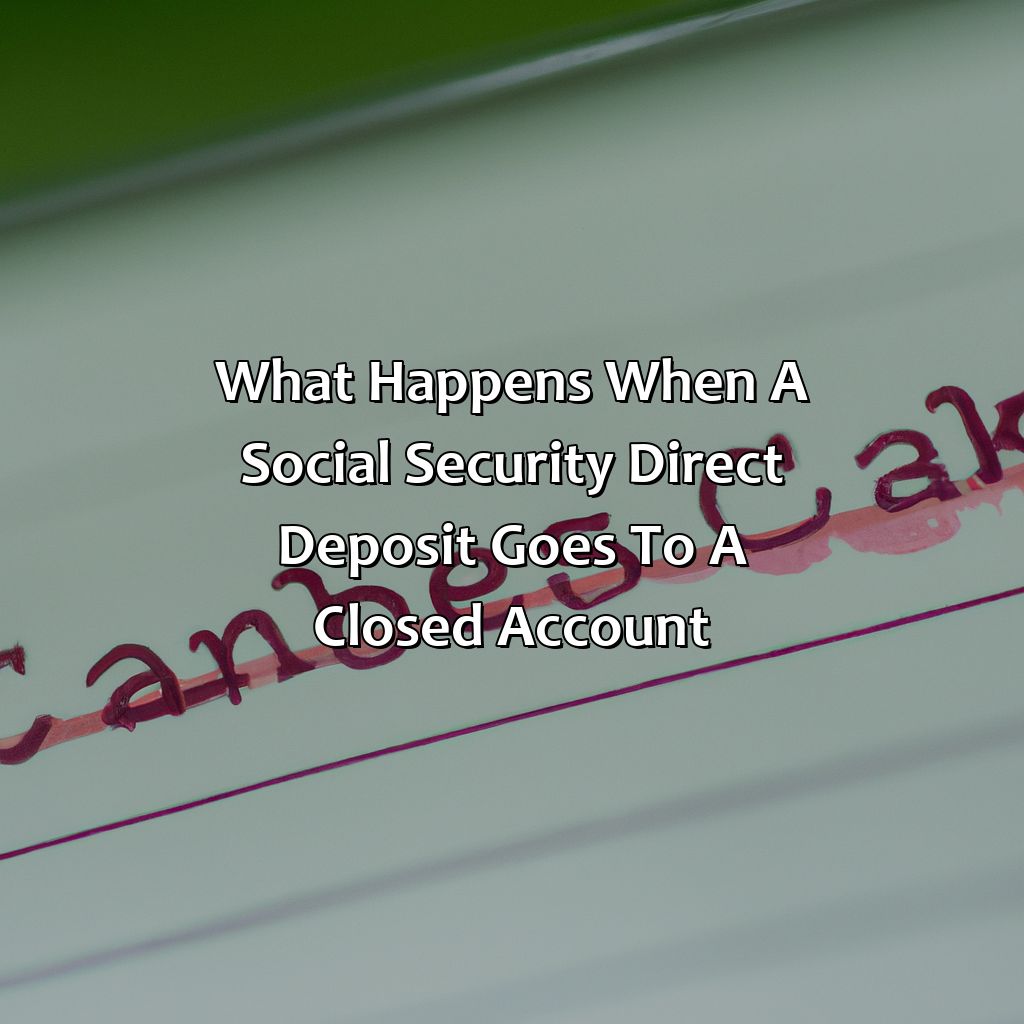What Happens When A Social Security Direct Deposit Goes To A Closed Account?
Key Takeaway:
- Direct deposits for Social Security benefits may go to a closed account due to various reasons, such as incorrect account information or bank errors.
- If a direct deposit goes to a closed account, the bank or credit union will handle the funds differently, which may result in delays in receiving Social Security benefits.
- To resolve the issue, one can contact the bank or credit union to request the funds be returned, contact the Social Security Administration to update account information or receive a paper check, and take steps to prevent future issues such as keeping account information up-to-date and signing up for alerts.
Worried about what happens when a Social Security direct deposit goes to a closed account? You’re not alone. This article will inform you of step-by-step instructions so you can reclaim your Social Security benefits.
What happens when a Social Security direct deposit goes to a closed account?
Know what occurs when a Social Security direct deposit is sent to a closed account? You must understand how direct deposit for Social Security benefits works. It could be for several reasons if your direct deposit reaches a closed account. These reasons involve, but are not restricted to…
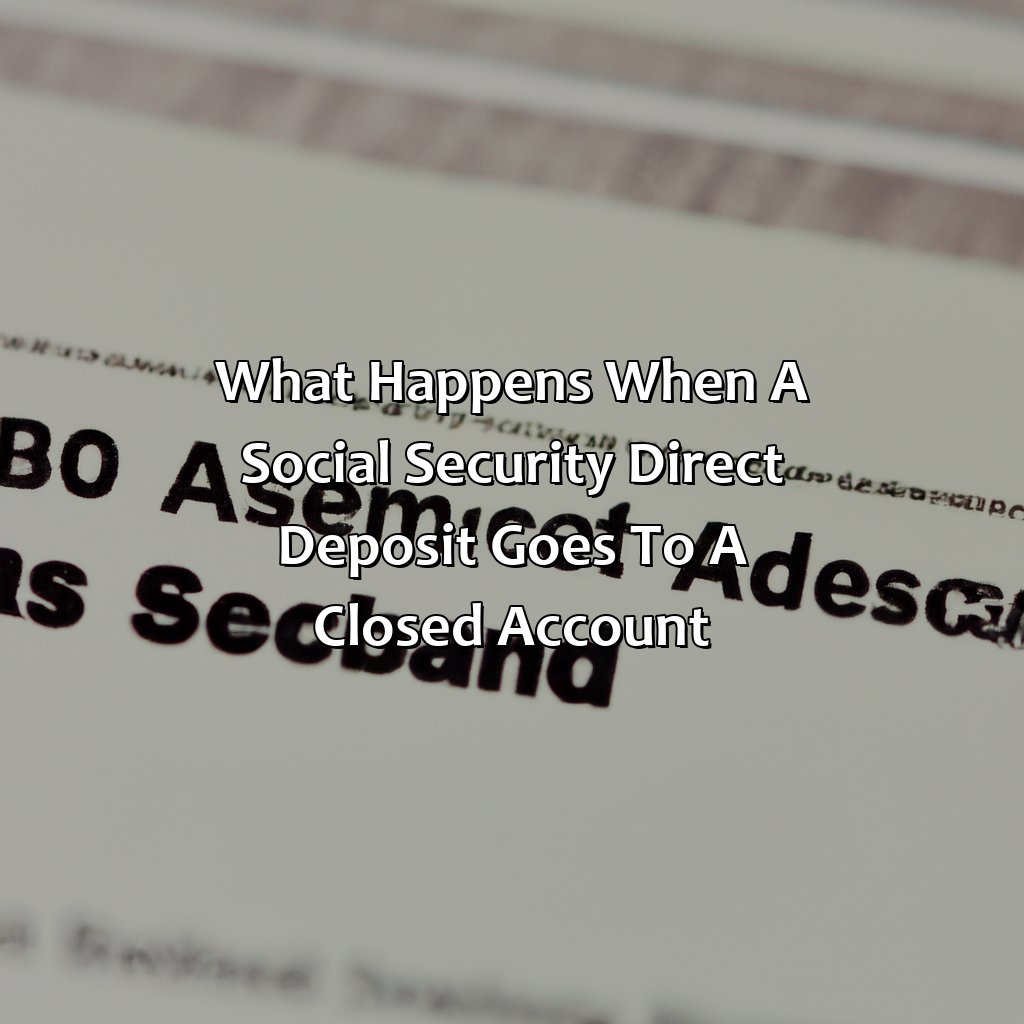
Image credits: retiregenz.com by James Duncun
Explanation of direct deposit for Social Security benefits
Direct deposit of Social Security benefits refers to the electronic transfer of funds from the Social Security administration to a recipient’s account. This method is faster, more secure, and convenient compared to receiving checks by mail. Direct deposit is also mandatory for most beneficiaries since May 1, 2011.
If a direct deposit goes to a closed account, the bank will usually reject or return the transaction back to the Social Security Administration. It can take up to two months for Social Security to receive and process returned deposits. Once processed, beneficiaries receive a paper check in place of a direct deposit.
It is crucial to make sure that all information given during enrollment or changes (such as account numbers and routing numbers) are accurate and up-to-date. If not sure of which information was given earlier, get in touch with the bank or use my Social Security service online.
Pro Tip: Always double-check account information before submitting it for direct deposit because an incorrect entry can cause delays and may lead to issues such as closed accounts.
Why settle for a lousy break-up when you can have a closed account break-up with your direct deposit?
Reasons why a direct deposit may go to a closed account
When a direct deposit is sent to a defunct account, it may happen due to various reasons such as the account holder changing banks or closure of the account. It can also occur when the bank has merged with another institution, resulting in closure of some accounts.
The failure of a direct deposit to hit the intended account may also happen because of data entry errors that involve incorrectly entering routing numbers or account numbers. When this occurs, it results in the transfer landing in another account, creating unintended consequences.
It’s vital for individuals to confirm whether their bank accounts are still active after making changes or deletion requests. It’s also crucial to re-check credentials such as routing numbers and ensure they correspond correctly before initiating any electronic funds transfers. Most banking facilities offer availability for users to update and edit old credentials as necessary.
Pro Tip: Maintain up-to-date banking information by frequently verifying details. Contacting one’s banking facility is simple and efficient and can help avoid confusion regarding returns on your funds invested otherwise spent during unexpected debacles with former accounts.
A closed account is like a black hole for direct deposits – once it’s gone, it’s gone for good.
Consequences of a direct deposit going to a closed account
To dodge a bad outcome from a direct deposit to a shut account, understanding its effects is key. In this part, we’ll talk about the results of such a move. Plus, we’ll take a gander at the wait for Social Security benefits and its outcome.
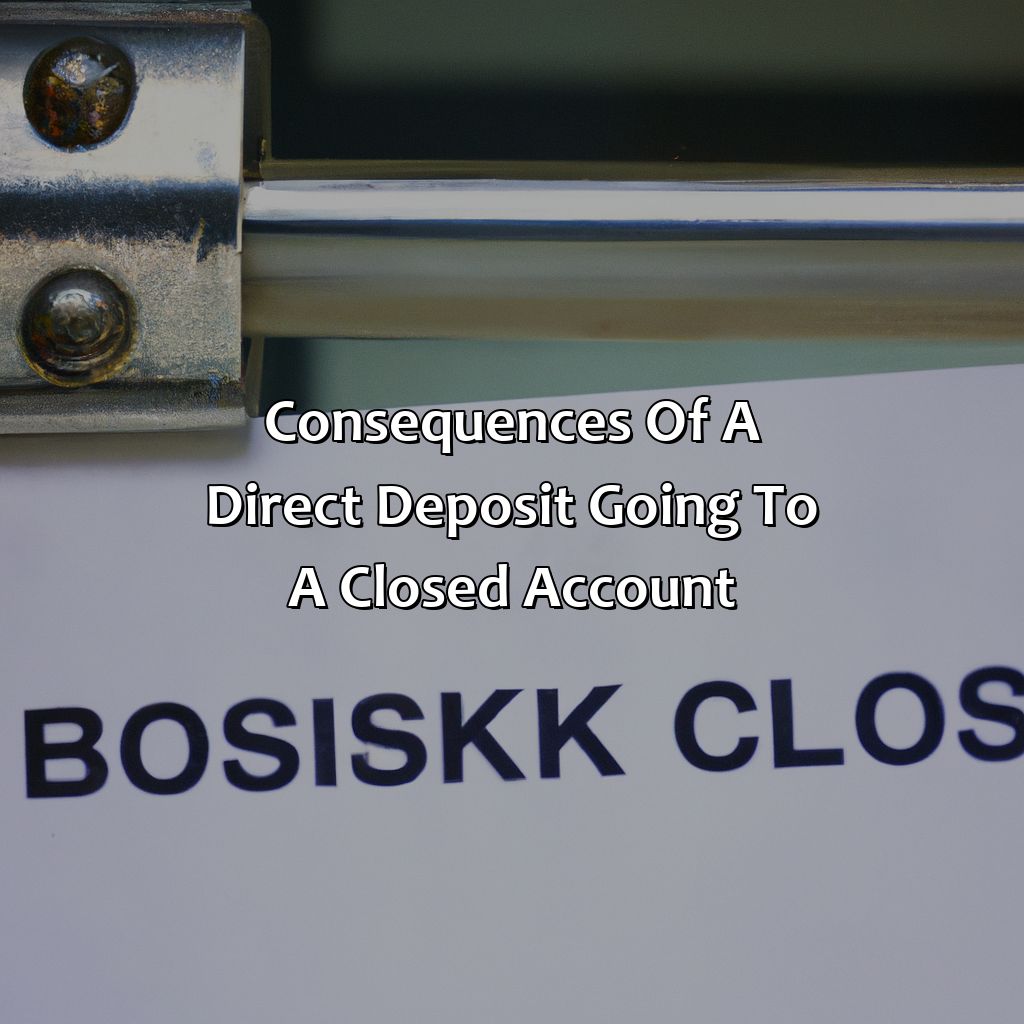
Image credits: retiregenz.com by Joel Duncun
How banks handle direct deposits to closed accounts
If a direct deposit is sent to a closed account, banks will generally reject the transaction and send the funds back to the sender. However, some banks may accept the funds and reopen the account to apply them. In such an eventuality, customers should contact their bank immediately to resolve any discrepancies that might arise. Failure to do so can lead to significant financial repercussions for both parties involved. Trust in online banking systems can be undermined as well.
It is worth noting that different banks may have varying policies regarding direct deposits to closed accounts. Some banks may also charge fees for returned deposit items or provide overdraft protection facilities, which they could use when incoming funds exceed available balances. Proper communication between customers and their respective banks is therefore necessary to prevent unpleasant surprises.
A case in point is how Wells Fargo came under scrutiny after failing to return Social Security direct deposits totalling more than $21 million belonging to deceased accountholders in 2018. As a result, the bank agreed in September 2020 to pay $7.8 million of compensation and interest due on behalf of the affected families who were unable to recoup their losses earlier.
Looks like Social Security benefits are playing hard to get, just like that person who doesn’t text back for days.
Delay in receiving Social Security benefits
The receipt of Social Security benefits can be delayed due to certain circumstances, such as a direct deposit being sent to a closed account. In this situation, the payment will not be able to be processed and will bounce back, causing a delay in receiving the funds. The delay can vary depending on how quickly the error is corrected by the recipient and Social Security Administration.
It is important to note that if a direct deposit is sent to a closed account, it may also incur additional fees from the bank. These fees can further impact the recipient’s ability to receive their benefits in a timely manner.
In cases where a delay does occur, it may be possible for the recipient to request an emergency payment while waiting for the issue to be resolved. This option is available in certain circumstances, such as financial hardship or lack of basic necessities.
According to AARP, an estimated 50 million Americans currently receive Social Security benefits. It is crucial that recipients ensure their payment information is accurate and up-to-date in order to avoid delays or other complications.
Fixing a direct deposit gone rogue is like playing a game of Operation with your bank account.
Steps to resolve the issue of a direct deposit going to a closed account
- Talk to the bank or credit union where the closed account is located.
- Contact the Social Security Administration.
- Receive a paper check instead of direct deposit.
Solve the problem with a direct deposit to a closed account from Social Security quickly!
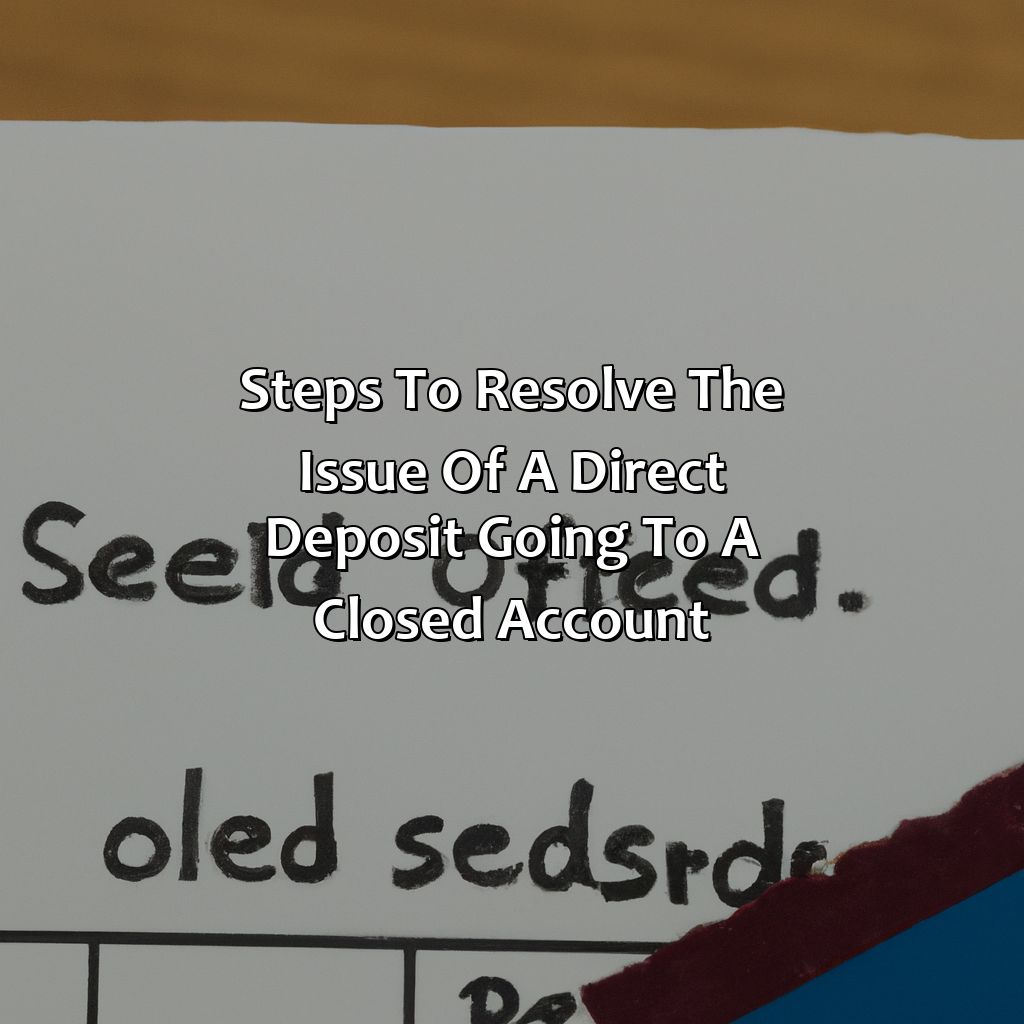
Image credits: retiregenz.com by David Woodhock
Contacting the bank or credit union
To resolve the issue of a direct deposit going to a closed account, it is necessary to initiate communication with the financial institution where the account was opened. This could involve contacting the bank or credit union through their customer service hotline or visiting their nearest branch.
Provide all relevant information about your Social Security direct deposit to the representative, and they will assist you in establishing a plan of action. Depending on the agreement you signed with them, you might be asked to fill out forms requesting that your direct deposit gets rerouted to a new account or that a refund check is issued.
In some cases, it may take several weeks for your funds to get processed. However, persistent follow-up can expedite the resolution process.
Pro Tip – To prevent possible complications in the future, ensure that you have provided an up-to-date mailing address to Social Security Administration and follow appropriate steps when closing down any checking accounts linked to direct deposits.
Calling the Social Security Administration is like trying to find a needle in a haystack, if the haystack was made of government bureaucracy and your needle was a live person.
Contacting the Social Security Administration
To connect with the Social Security Administration for assistance with a direct deposit issue, call their official helpline or visit them in-person. You will need to provide your Social Security number and present identification proof when speaking with a representative.
If you contact them by phone, it is recommended that you do so during non-peak hours to avoid longer wait times. When reaching out to the Administration for help, be sure to have your updated bank account information ready and notify them of the previous deposit error.
Note that you should not rely solely on paper checks as an alternative solution since they may take longer to arrive and aren’t always reliable due to postal delays.
Pro Tip: To prevent future mishaps, consider setting up alerts with your bank for balance changes or payment credits. This feature can help you stay informed about any incoming deposits and match the date with expected payments from government agencies like Social Security.
Looks like it’s time to dust off that old checkbook and embrace the joys of snail mail once again.
Receiving a paper check instead of direct deposit
Receiving Payment via a Printed Check Instead of an Electronic Deposit
When encountering issues with direct deposit, such as an account being closed, a paper check may be administered for the payment. This is an alternative method commonly employed to avoid any delays in receiving the payment due.
This alternate process may take longer than a direct deposit and thus it is necessary to authorize this change in payment mode. The request can be made through contacting the source of payment.
Pro Tip: Ensure that accurate and up-to-date information regarding the bank account is provided to prevent future complications.
Keep your direct deposit on the straight and narrow by double-checking your account info like it’s your ex’s Instagram.
Preventing future issues with your direct deposit
Take a proactive approach to prevent future direct deposit problems. Let your bank or credit union know of any changes. Double-check account information before submitting. Sign up for email or text alerts to monitor account activity. These steps help ensure your direct deposit goes through correctly and without issues.
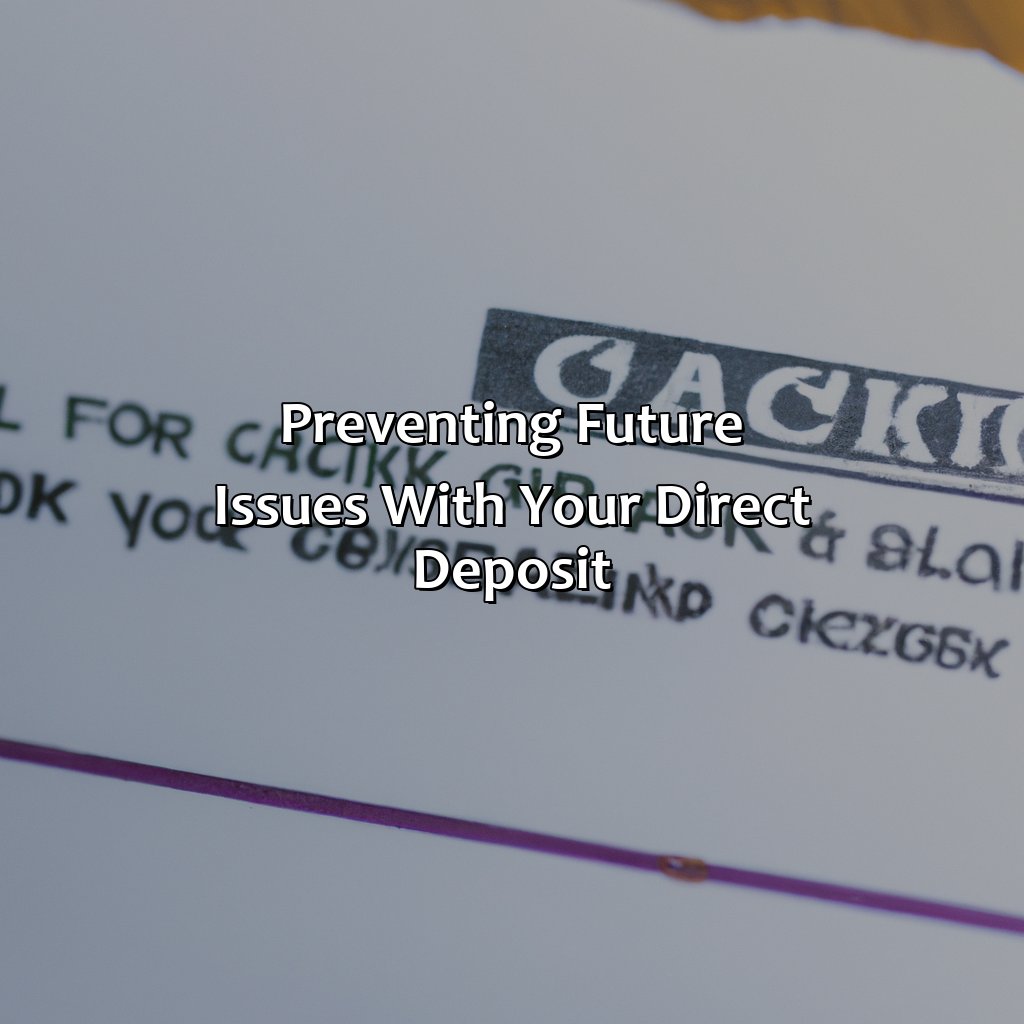
Image credits: retiregenz.com by Adam Duncun
Keeping your bank or credit union informed of changes
To ensure your direct deposit is processed smoothly, it is essential to maintain regular communication with your banking institution. Keeping them informed of any changes regarding your financial situation, such as a new account or change in address, can prevent potential issues.
By maintaining open lines of communication, your bank or credit union can keep their records up-to-date and ensure that your funds are being directed to the right place. This not only saves you time and hassle but also reduces the risk of unauthorized access to your account.
Furthermore, it’s important to regularly review and update your direct deposit information to avoid any potential issues. If there have been recent changes in your financial situation or employment status, you should inform the bank immediately to ensure that your direct deposits are directed correctly.
Pro Tip: Take advantage of online banking services and alerts offered by your institution to stay on top of any changes or potential issues with your direct deposit.
Checking your account information twice is like putting on a seatbelt twice – it may seem unnecessary, but it could save you a world of pain.
Double-checking account information before submitting
It is essential to verify banking credentials prior to submission. Neglecting this may cause issues like social security direct deposit transfer failure. Here’s how you can avoid such problems and ensure smooth transference:
- Verify and re-verify account number and routing information.
- Confirm with your bank representative, there are no typos or outdated details
- Tally the previously deposited amount with the most recent transactions
- Ensure that adequate balance is available for smooth transaction processing
- Educate yourself about cut-off periods and required processing timeframes
While making an online transaction, enter details carefully. This will importunately prevent unforeseen errors and delay in payments. It’s quintessential to double-confirm your entries before submitting them.
In addition, always remember to allocate a reasonable duration for banks’ approval of banking details changes since mistakes during these minutes can lead to a future issue of your social security payment going into someone else’s account.
History has shown business owners neglect crosschecking routing numbers due to excessive workload leading to dark times when crucial transfers did not happen on time.
Signing up for email or text alerts to monitor account activity
With the rise of digital banking, monitoring your account activity has become more accessible. Enabling notifications through your online banking is a dynamic way of tracking transactions and receiving updates on your account health.
- Signing up for email or text alerts to monitor account activity provides real-time updates and helps detect fraud.
- Enabling notifications can assist you in managing your budget efficiently and avoiding overdraft fees.
- This feature also helps users identify unusual transactions, notifying them of unauthorized activities on their accounts.
- Email or text alerts also help monitor scheduled payments to avoid late fees or insufficient funds charges.
- This feature is beneficial for people who have more than one account as they can receive notifications for all accounts at once.
- Notifications also provide transparency by keeping you informed about your balances, which could prevent unnecessary spending.
It’s important to note that only enabling notifications does not substitute following other safety measures such as enabling two-factor authentication, using strong passwords and keeping software up to date.
Enabling email or text notifications compliments your overall digital banking experience by easing the management of multiple accounts, preventing fraudulent activities and keeping track of scheduled payments.
According to AARP, Social Security paid $3.1 billion into suspended or closed bank accounts between 2006 and 2010.
Five Facts About What Happens When a Social Security Direct Deposit Goes to a Closed Account:
If a Social Security direct deposit goes to a closed account, it may be returned to the Social Security Administration (SSA) by the bank. (Source: SSA)
It may take several weeks or more for the SSA to receive the returned payment. (Source: SSA)
Once the payment has been returned, the SSA will issue a paper check and mail it to the address on file. (Source: SSA)
To avoid this issue, it is important to keep banking information up to date with the SSA. (Source: AARP)
In some cases, the bank may apply the payment to a different account if it was reopened or transferred to a different bank. (Source: SSA)
FAQs about What Happens When A Social Security Direct Deposit Goes To A Closed Account?
What happens when a social security direct deposit goes to a closed account?
When a social security direct deposit goes to a closed account, the bank will typically reject the deposit and send it back to the Social Security Administration (SSA). The SSA will then issue a paper check and mail it to the individual’s address on file. This process can take up to several weeks.
Can I expedite the process of getting a paper check?
Unfortunately, there is no way to expedite the process of getting a paper check. The SSA does not have the ability to issue emergency or same-day payments. If an individual needs their benefits immediately, they may be able to apply for an “emergency advance payment” through the SSA.
What happens if the closed account is reopened before the deposit is returned?
If the closed account is reopened before the deposit is returned, the bank will typically accept the deposit and credit it to the account. The individual should contact their bank to confirm that the deposit has been credited to their account.
What happens if the closed account belongs to a deceased person?
If the closed account belongs to a deceased person, the bank will typically reject the deposit and send it back to the SSA. The SSA will then issue a paper check to the deceased person’s estate or surviving spouse.
How can I avoid having my social security deposit go to a closed account?
To avoid having your social security deposit go to a closed account, it is important to keep your banking information up to date with the SSA. You can update your information online, by phone, or by visiting a local SSA office. It is also important to notify the SSA immediately if your account is closed or if you switch banks.
What should I do if my social security deposit has not been returned or credited to my account?
If your social security deposit has not been returned or credited to your account within several weeks, you should contact the SSA to report the issue. They may be able to issue another paper check or take other steps to remedy the situation.
 Checkout this IRS Loophole
Checkout this IRS Loophole 
